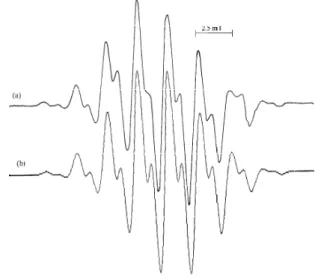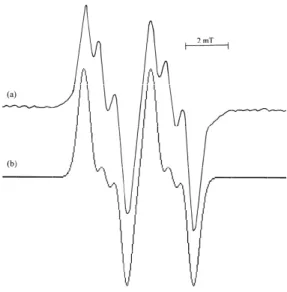306 Murat Aydin
Identification of Free Radicals Induced by Gamma Irradiation in Amino Acid Derivatives
Murat Aydin∗
Faculty of Education, Adıyaman University, TR 02030-Adıyaman, Turkey
(Received on 14 December, 2009)
Powders of N-acetyl-L-leucine and N-methyl-L-glutamic acid were gamma irradiated and the free radicals formed were investigated at room temperature by electron paramagnetic resonance technique. The free radicals formed in compounds were attributed to the (CH3)2CCH˙ 2CH(NHCOCH3)COOH and
HOOCCH2CH2C(NHCH˙ 3)COOH radicals respectively. Both radicals are very stable and we could observe
them for five months without almost intensity diminution at room temperature. Thegvalues of the radicals and the hyperfine structure constants of the free electron with nearby protons and14N nucleus were determined. The results were found to be in good agreement with the existing literature data.
Keywords: Gamma irradiation, EPR, Free radicals, Leucine, Glutamic acid.
1. INTRODUCTION
Free radicals are important constituents of many reaction mechanisms and they significantly contribute to normal func-tioning of the organisms as well as to development of patho-logical process [1-4].
The electron paramagnetic resonance (EPR) has been widely used for the identification of irradiation damage centers in many substances including amino acid and their derivatives [5-15]. In previous study, Almanov et.al. [16] were showed that two types of radicals were observed in gamma irradiated single crystal of N-acetyl-L-leucine at room temperature; (CH3)2CCH˙ 2CH(NHCOCH3)COOH
and (CH3)2CHCH2C(NHCOCH˙ 3)COOH. Furthermore,
N-carbamoyl-L-glutamic acid were gamma irradi-ated and studied at room temperature with EPR [17]. The radiation damage center was attributed to the HOOCCH2CH2C(NHCONH˙ 2)COOH radical.
Leucine and glutamic acid provide many benefits to the body. Leucine is important for the regulation of protein syn-thesis and is essential in the building of muscle tissue. Glu-tamic acid is a potential source of energy and it is important in brain metabolisms. To our knowledge N-acetyl-L-leucine, (CH3)2CCHCH2CH(NHCOCH3)COOH, and
N-methyl-L-glutamic acid, HOOCCH2CH2CH(NHCH3)COOH,
pow-ders have been not investigated. Therefore it is the purpose of this work to identify and check the stabilities of the rad-ical species formed in these two amino acid derivatives by gamma irradiation at room temperature.
2. EXPERIMENTAL
The samples used in this study were obtained from com-mercial sources. Powder samples of the compounds were exposed to gamma-irradiation from60Co gamma-ray source
(Nordion-Canada model JS 9600) at dose rate of 2 kGy/h for a total of 10 h at room temperature. After irradiation, samples were kept in plastic bags at room temperature in the dark. The spectra of samples were recorded by putting the sample in quartz sample tube. The EPR measurements
∗Electronic address:muraydinat@gmail.com
was carried out in a Varian model X-band E-109C EPR spectrometer at room temperature. The modulation ampli-tude was below 5.10−2mT and the microwave power was 2 mW. Thegfactors were found by comparison with a dipen-hylpicrylhydrazyl (DPPH) sample with of g=2.0036 [18, 19]. The spectrum simulations were made using McKelvey’s programs [20].
FIG. 1: (a) The EPR spectrum of gamma irradiated NAL powder at room temperature, (b) simulation form of the spectrum using
a(CH3)2=2.13 mT,a(1)β =2.13 mT,a(2)β =0.73 mT and linewidth 0.40 mT.
3. RESULTS AND DISCUSSION
Before the gamma irradiation of powders of N-acetyl-L-leucine (NAL) and N-methyl-L-glutamic acid (NMGA), samples did not give any EPR signals. The EPR spectra of gamma irradiated samples are shown in figures 1, 2.
Brazilian Journal of Physics, vol. 40, no. 3, September 307
FIG. 2: (a) The EPR spectrum of gamma irradiated NMGA pow-der at room temperature, (b) simulation form of the spectrum using
a(1)β =3.00 mT,aN=0.65 mT and linewidth 0.40 mT.
lines are also doublets with a splitting spacing of 0.73 mT. We may assume that this EPR spectrum belongs to the (CH3)2CCH˙ 2CH(NHCOCH3)COOH radical. It is also
de-termined that the hyperfine coupling constants of the protons of the two rotating methyl groups and one of the methylene protons is similar in value 2.13 mT and the coupling with the second methylene proton is small in value 0.73 mT. The measured value of thegfactor is 2.0032±0.0005. The simu-lation of the spectrum, with the above given values, is shown in figure 1b.
The g value and the hyperfine constants of methyl pro-tons of the radical discussed here agree well with some other literature data [21-24]. In the gamma irradiated N-formyl-L-leucine, at room temperature, the free radical has been at-tributed to the (CH3)2CCH˙ 2CH(NHCOH)CO2radical [25].
This is similar to our proposed radical and the reported val-ues of a(CH3)2=2.4 mT anda(1)β =2.40 mT are in good agreement with our results. A radical similar to this has been observed in the gamma irradiated L-leucine methyl ester hy-drochloride powders [26], but the hyperfine coupling con-stants of methylene protons (3.80 and 0.9 mT) are higher than the values reported here. Similar values of the hyper-fine coupling constants of the methylene protons have been found in the gamma irradiated Al6O4(OH)10(leucine)·5H2O
system as 2.30 mT and 0.70 mT [27]. We can state that the (CH3)2CCH˙ 2CH(NHCOCH3)COOH radical is obtained by
the removal of hydrogen atom from the tertiary carbon atom of the NAL.
The characteristic stable EPR spectrum of the NMGA powder at room temperature is shown in figure 2a. This spectrum is a doublet of triplets. When the spectrum is
ex-amined thoroughly, it can be seen that it consists of a blet with a spacing of 3.00 mT. Then each line of the dou-blet is further subdivided into 3 lines of spacing 0.65 mT. These indicate the hyperfine coupling of the unpaired elec-tron with one of the methylene protons and a nitrogen nu-cleus (I=1). Therefore we attribute the species to the radi-cal HOOCCH2CH2C˙(NHCH3)COOH. Theg values of this
radical is measured as g = 2.0027 ± 0.0005. A simu-lation of the spectrum is shown in figure 2b, using the hyperfine coupling constants a(1)β = 3.00 mT and aN =
0.65 mT. The experimental and simulated EPR spectrum is found to agree well with each other. The above given values of the hyperfine coupling constant agree well with some other literature values of amine radicals [28-32]. Sin-gle crystal of the gamma irradiated Nα-acetyl L-glutamic acid has been investigated at room temperature and the ra-diation damage centre of this sample has attributed to the HOOCCH2CH2C(NHCOCH˙ 3)COOH radical [33]. The
re-ported average values of the hyperfine constants area(1)β =
3.65 mT and aN =0.56 mT. This radical and the reported
EPR parameters are fairly similar to the radical obtained from NMGA.
In the HOOCCH2CH2C˙(NHCH3)COOH radical, only one
proton of the methylene group show a resolvable coupling. Other proton of the methylene group lies in the nodal plane of the pπorbital and thus produces no hyperfine coupling [34-35]. The coupling to theβ-proton in this radical occurs pri-marily through hyperconjugation, and the magnitude of the splitting depends on the dihedral angle θbetween the C-H bond and the pπ orbital which contains the unpaired elec-tron. Theβ-proton coupling constant is given by [36]
aβ=B0+B1cos2θ. (1)
In this equation the constantsB0andB1have been
experi-mentally determined as 0.32 and 4.36 mT, respectively [33]. Substitution of the observed value ofa(1)β =3.00 mT into equation (1) yields a value of 380forθ. The much smaller value of the hyperfine coupling constant (<0.4 mT) of the
second proton of the methylene group must be due to itsθ
value of 900m [33]. Hence we can state that theβ-proton in this radical rotates aboutCα−Cβand this rotation of the β-proton exists at room temperature.
4. CONCLUSION
The gamma irradiated NAL and NMGA samples indicated the inducement of (CH3)2CCH˙ 2CH(NHCOCH3)COOH
alkyl type and HOOCCH2CH2C(NHCH˙ 3)COOH amine type
radicals respectively. The EPR parameters and the structure of the radicals could be determined. The measurements of magnetic properties of these radicals can be helpful in the study of similar radicals found in biological systems.
[1] K.J.A. Davies and W. A. Pryor, Free Radic. Biol. Med.,39, 1263 (2005).
308 Murat Aydin
Bimol. Spectrosc.,63, 840 (2006).
[3] J. Kiljunen, E. Popov, H. Kunttu and J. Eloranta, J. Chem. Phys.,130, 164504 (2009).
[4] N. Metreveli, L. Namicheishvili, K. Jariashvili, M. Dgebuadze and E. Chikvaidze, J. Photochem. Photobiol. B: Biol.,93, 61 (2008).
[5] H. Shields, P. Hamrick and D. Delaigle, J. Chem. Phys.,46, 3649 (1967).
[6] D.M. Zengin, M. Birey, H. Aktas¸ and A. Hancer, Z. Natur-forsch.,51a,895 (1996).
[7] N.D. Yordanov and K. Ranguelova, Spectrochim. Acta. A., 56,
373 (2000).
[8] N.D. Yordanov and B. Mladenova, Radiat. Phys. Chem.,60,
191 (2001).
[9] L. Bachmann, A.B. dos Santos, S. Baffa, D.M. Zezell, Spec-troscopy Lett.,36, 487, (2003).
[10] M. Tabak, D. de Sousa Neto and C.E.G. Salmon, Braz. J. Phys.,36,83 (2006).
[11] Kinoshita, L. Figuty and O. Baffa, Braz. J. Phys., 36, 93 (2006).
[12] F. Chen, C.F.O. Graeff and O. Baffa, Nucl. Instr. and Meth., Phys. Research B,264,277 (2007).
[13] N.D. Yordanov and K. Aleksieva, Radiat. Phys. Chem., 78,
213 (2009).
[14] M. Aydin, M.H. Baskan and Y. Osmanoglu, Braz. J. Phys.,39,
583 (2009).
[15] N.D. Yordanov, O. Lagunov and K. Dimov, Radiat. Phys. Chem.,78,277 (2009).
[16] G.A. Almanov, G.A. Bogdanchikov, P.V. Schastnev and Y.V. Gatilov, High Energy Chem.,20, 430 (1986).
[17] S¸. Osmanoˇglu, M. Aydin and M.H. Bas¸kan, Z. Naturforsch.,
60a,549 (2005).
[18] N. D. Yordanov and A. Christova, Appl. Mag. Res.,6, 341
(1994).
[19] N. D. Yordanov, Appl. Mag. Res.,10, 339 (1996). [20] R. D. McKelvey, J. Chem. Educ.,64,497 (1987).
[21] V.N. Laslo, T.A. Himdan and H. Bilinski, Radiat. Resear.,132,
1 (1992).
[22] D¸ . Osmanoˇgu and M. H. Bas¸kan, Z. Naturforsch.,58a,290 (2003).
[23] S¸. Osmanoˇglu and M. H. Bas¸kan, J. Chem. Research (s), 26 (2003).
[24] M.H. Bas¸kan, S¸. Osmanog¸lu and I.Y. Dicle, Radiat. Eff. De-fects Solids,164,673 (2009).
[25] G.A. Almanov, G.A. Bogdanchikov and O. M. Usov, J. Struc-tural Chem.,36, 912 (1989).
[26] I. Kartal, F. K¨oksal and F. Ucun, J. Chem. Research(s), 118 (1996).
[27] V.N. Laslo, T.A. Himdan and H. Bilinski, Radiat. Phys. Chem.,37,169 (1991).
[28] D.E. Wood and R. V. Lloyd, J. Chem. Phys.,53,3932 (1970). [29] P. Neta and R. W. Fessenden, J. Phys.Chem.,75,738 (1971). [30] D.M. Close, G.W. Fouse and W.A. Bernhard, J. Chem. Phys.,
66, 1534 (1977).
[31] R. K¨oseoˇglu, E. K¨oseoˇglu and F. K¨oksal, App. Radiat. Isot.,
58,63 (2003).
[32] M. Aydin, Y.E. Osmanoˇglu and M.H. Bas¸kan, Radiat. Eff. De-fects Solids,163,47 (2008).
[33] F. K¨oksal, S¸. Osmanoglu, I. Kartal and F. Ucun, Radiat. Phys. Chem., 49, 537 (1997).
[34] D.H. Whiffen, Pure Appl. Chem.,4,185 (1962).
[35] W. Bernhard and W. Snipes, Proc. Natl. Acad. Sci. U S A.,59, 1038 (1968).

